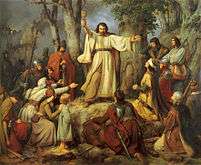Karl Friedrich Lessing
Karl Friedrich Lessing (15 February 1808 – 4 January 1880) was a German historical and landscape painter, grandnephew of Gotthold Ephraim Lessing.[1][2]
Biography


He was born near Breslau, and was a pupil of Heinrich Anton Dähling at the Berlin Academy. He first devoted himself to landscape. In his the period of his artistic career Lessing was influenced by the landscapes of Caspar David Friedrich: his themes he depicted were castle ruins, forgotten cemeteries, rugged rock formations, which he inhabited with figures of monks, knights and thieves. In 1826 obtained a prize with his Cemetery in Ruins. He accompanied Friedrich Wilhelm Schadow to Düsseldorf, where he continued his studies, devoting himself to historical paintings. In 1830, when Schadow went to Italy, Lessing occupied his place as director of the academy, exercising great influence on the Düsseldorf school of painting. His picture Das trauernde Königspaar (Mourning Royal Couple) brought him great popularity. In 1837, he received a gold medal at Paris; he was a member of the Berlin Academy and was the recipient of several orders. In 1858 he was appointed director of the gallery at Karlsruhe, where he continued his activity as a painter until his death in 1880.[3]
- Selected works by Karl Friedrich Lessing
 Romantische Landschaft mit Klosteranlage, 1834
Romantische Landschaft mit Klosteranlage, 1834 Hussitenpredigt, depicting Hussites
Hussitenpredigt, depicting Hussites Last Crusader
Last Crusader- Waldkapelle
 The Robber and His Child
The Robber and His Child
References
- ↑ "Karl Friedrich Lessing". /encyclopedia2.thefreedictionary.com. Retrieved 6 March 2015.
- ↑ Atkinson, J. Beavington (September 1865). "German Painters of the Modern School. No. VIII.—Karl Friedrich Lessing". The Art Journal: 261–265.
- ↑ "Karl Friedrich Lessing". www.oxfordreference.com.
Notes
- Wilhelm Jordan, Ausstellung der Werke Karl Friedrich Lessings (Berlin, 1880)
 This article incorporates text from a publication now in the public domain: Gilman, D. C.; Peck, H. T.; Colby, F. M., eds. (1905). "article name needed". New International Encyclopedia (1st ed.). New York: Dodd, Mead.
This article incorporates text from a publication now in the public domain: Gilman, D. C.; Peck, H. T.; Colby, F. M., eds. (1905). "article name needed". New International Encyclopedia (1st ed.). New York: Dodd, Mead.
See also
External links
| Wikimedia Commons has media related to Carl Friedrich Lessing. |